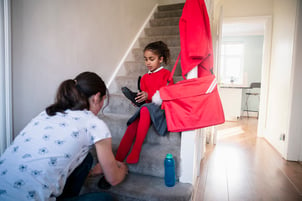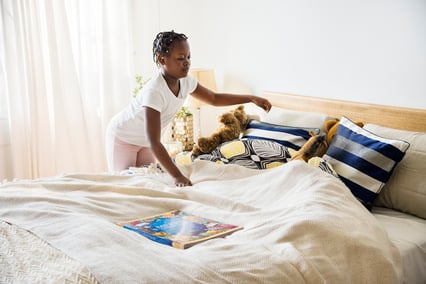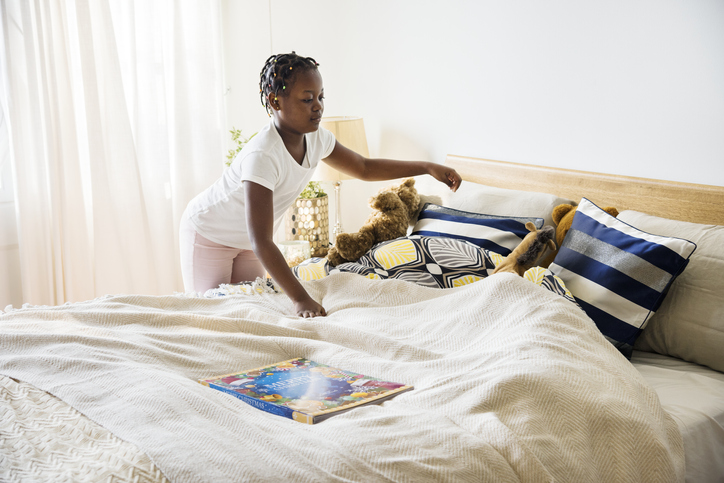7 Tips to Get Your Child Back into the School Routine
Summer is near the end and it’s almost time to head back to school! Gearing your child up for a normal school routine after summer fun is no easy feat. However, practice makes perfect! We know autistic children thrive with consistency and previewing, so these seven tips should provide some comfort before that first day of school appears.
1. Practice morning routines
 As a child, I was never a fan of the week before school started, because my parents bumped my siblings and my wakeup call a little earlier than our typical summer snooze. That’s one way to kill the “last week of summer” vibe. But in theory, it helped us when our school alarms blared and we had a routine to accomplish before our commute to school. You know your morning routines best. Get in the habit of filling out a schedule for your child. What do they need to accomplish before getting an earned break? Do you have visual cue cards for your child to indicate their steps? The more familiar your child gets with their routines and how to complete them, the better off they will be when it’s crunch time.
As a child, I was never a fan of the week before school started, because my parents bumped my siblings and my wakeup call a little earlier than our typical summer snooze. That’s one way to kill the “last week of summer” vibe. But in theory, it helped us when our school alarms blared and we had a routine to accomplish before our commute to school. You know your morning routines best. Get in the habit of filling out a schedule for your child. What do they need to accomplish before getting an earned break? Do you have visual cue cards for your child to indicate their steps? The more familiar your child gets with their routines and how to complete them, the better off they will be when it’s crunch time.
2. Create a mock school day
Every school year will look a bit different than the previous year. Whatever approach your school has adopted, your child may inevitably feel anxious straying from their typical school routines. Find a way to preview these schedule changes with your child and allow them to ask questions. Their questions may be validated by your immediate response, or you may have to relay your child’s questions to school administrators. Before school begins, carve out a portion of a day to have a “mock school day.” No academic work has to be completed, but you can take time to help your child familiarize themselves with getting ready for school, in-school expectations, as well as online learning expectations if they are participating virtually in any capacity.
3. Create a basket of self-break strategies and design a self-break card to use at school or at home
Depending on your child’s school setting, their classroom may already have a designated space or time of the day where they can utilize coping strategies to ensure students are ready to engage in classroom expectations. If your child is participating in virtual learning in some capacity, the responsibility may shift to you to acknowledge when your child needs a self-break strategy. Designing a self-break card allows your child to creatively decorate a nonverbal cue that screams “Hey! I need a break from this!” When you see your child signal this card, you can direct them to your self-break strategy basket where they can choose options that match their Zones of Regulation. Practice reviewing Zones of Regulation and emotional vocabulary with your child. Then, familiarize yourselves with what coping strategies work best for your child. In some capacity, quizzing your child on what strategies match what feelings they may experience can guide them in autonomizing their self-break strategy selection.
4. Practice timing everyday tasks
 Your child will have to get used to being in classes for a duration of time. Our Time Timer provides children with a large visual timer to help them pace themselves. Practice breaking up a morning routine, afternoon activities, or an errand run by an allotted time frame. You can use a schedule and earned break tracker mentioned above to preview activities with your child. On the tracker, you can put how long they are expected to participate in each activity, followed by their earned break options and time limits. For example, if you were outlining your child’s morning routine with the tracker, you may list the following:
Your child will have to get used to being in classes for a duration of time. Our Time Timer provides children with a large visual timer to help them pace themselves. Practice breaking up a morning routine, afternoon activities, or an errand run by an allotted time frame. You can use a schedule and earned break tracker mentioned above to preview activities with your child. On the tracker, you can put how long they are expected to participate in each activity, followed by their earned break options and time limits. For example, if you were outlining your child’s morning routine with the tracker, you may list the following:
- Make your bed (5 minutes)
- Get dressed (10 minutes)
- Eat breakfast (20 minutes)
- Put dishes in dishwasher (3 minutes)
This will help your child practice time management, transitions, and individual responsibility.
5. Practice 15 minutes of basic academic review every day
During the summer or vacation time, it is important to practice some basic academics for a small amount of time to help jog your child’s memory of all of the foundational academic skills they’ve gained and get them in the habit of sitting down and working through academic tasks. Give your child the autonomy to choose the subject and the medium in which they want to practice that subject. For example, if your child chooses to practice math, give them the option of flashcards, a few expressions to solve, or a math game. Use the resources you have to provide options and refrain from power struggles if this amount of time feels too long. Even five minutes a day discussing academics can help your child conceptualize that school is returning and they are more than capable of tackling this year’s academic journey.

6. Read!
If formal academic practice feels daunting, read with your child! Perhaps this is something you do already, but reading not only increases vocabulary knowledge but also models valuable perspective-taking and emotional intelligence skills for your child.
7. Let your child help pick out their school supplies
There’s so much excitement about having new school supplies to start the school year. They can show off a child’s personality, and in turn, can make learning a little more fun when they like what they are using. Take your child with you when school supply shopping, whether it be in-store or online, and let them pick out some items and item colors. When they are in your possession, let them help you label their materials with their name and by subject. This autonomy can foster excitement to use these materials and serve as a preview for your child of what materials will be used during what times of their day, and for what purpose.

Danielle Fowler
Danielle Fowler has had an interest in child psychology since high school. After pursuing her Bachelor’s Degree in Psychology and Early Childhood Education at Elon University in 2017, Danielle went on to learn more about the child development realm. She earned her Ed.M in Human Development and Psychology from Harvard Graduate School of Education in May of 2018. By July of that same year, she was knee deep in the work of a behavioral counselor at The Manville School, a therapeutic school in Boston, offering proactive social, emotional, and academic supports to students with a range of psychological diagnoses. This job has provided Danielle with a plethora of hands on work and personal experiences working with students on the autism spectrum. Danielle has recently been accepted as a PhD Candidate in School Psychology at UMass Boston and will dive deeper into learning about positive behavior interventions and supports (PBIS) models. Her overall career goal is to become a school psychologist and to work clinically with similarly presenting students as those at her first job site.





